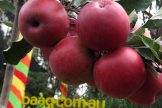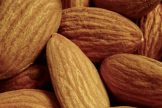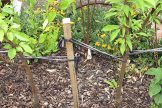
Pistachio are the world’s most delectable nut! Salted, made into Baklava, added to salads or rice dishes. Originating from Persia in the Middle East, they grow on long-lived, 10m tall, deciduous trees which are related to cashew nuts. Pistachio trees are dioecious, meaning that the male and female flowers occur on different plants.
The pistachio is a desert plant, highly tolerant of saline soils and surviving frost and temperatures from −10°C to 48°C. They need a well-drained position to avoid root rot in winter. Long, hot summers are required for the fruit to ripen fully.
Pistachio bear fruit biennially, with heavier crops every second year. It takes 7 to 10 years to reach a significant crop, and peak production is at around 20 years old. One male tree produces enough pollen for 8 to 12 drupe-bearing females. The nuts are ready for harvest at the end of summer when they have changed from red to pink/yellow and the husks are easy to remove. If the husks do not change colour and the husks do not rub off, then the nuts have not been pollinated and the shells will be empty.
Plant your pistachio in a full sun position, in slightly acid to neutral pH soil. Male and female plants should be spaces between 2m and 6m apart, with the male planted upwind of the prevailing October wind direction from the female. Although pistachio are drought tolerant, they require consistent watering for good fruit production. Fertilise twice a year in spring and autumn.
Prune to a height that is convenient to pick the nuts as fallen nuts should not be eaten. Pistachio are not suitable to humid summers as nuts are susceptible to fungal diseases. Always harvest, dehusk and dry your nuts as soon as possible after ripening as they deteriorate quickly if left on the tree. Never eat mouldy nuts as Aflatoxins may be present.
The dominant variety Sirora was selected by CSIRO in the 70’s. It is productive with large, light coloured nuts with good even splitting and excellent flavour.





